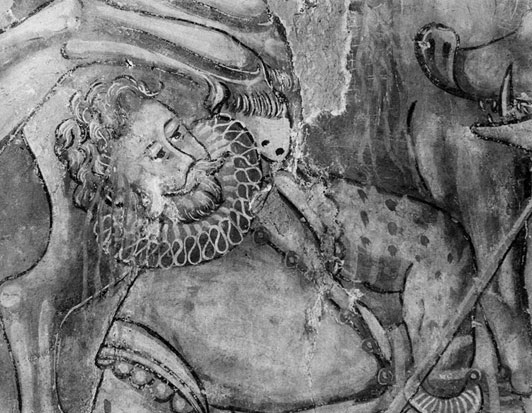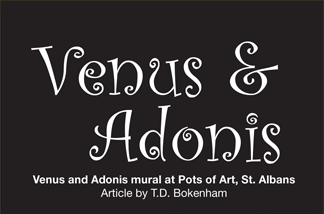This important national treasure is on view to the public. The painting covers the whole of one wall in the Pots of Art studio, St. Albans.
In 1985 a fine mural was discovered when the panelling in a room which was part of the famous The White Hart public house was removed. The discovery was reported only in the local Press and the photographs then produced showed few recognisable features which identified its subject. However, the Warburg Institute and the eminent Dr. Clive Rouse were able to inspect it and Dr. Rouse gave a glowing report stating it was a priceless discovery which can only be matched in places like Hampton Court. In 1986, the painting was again enclosed in its panelling, though not before Francis Carr was able to make some detailed photographs. No further notice appears to have been made to this peculiar situation until the room was let by the Brewers to a bedroom shop, the proprietors of which decided to exhibit parts of this large painting which they have protected by glass panels.
The death of Adonis depicted in the important mural is clearly connected with the story of Venus and Adonis in which Adonis, having been killed by a boar, is restored as a flower “the colour of his blood on the ground.”
In R.P. Knight’s Enquiry into Symbolic Language of Ancient Art (1876), we are reminded that “Adonis, or Adonae, was the Oriental title of the Sun, and the boar supposed to have killed him was the emblem of Winter during which the productive powers of nature were suspended until Adonis was restored to life.”
Shakespeare’s Adonis was restored as a rose and the classical scholar, W.F.C. Wigston, tells us in his Bacon, Shakespeare and the Rosicrucians (1888) that “Adonis was the key figure or myth centre round which the society of the Rosy Cross and their emblem revolve” (p.87). That emblem is a Cross adorned with a Rose.
The allegory of Venus and Adonis is very ancient and Wigston also tells us that in the poetical tales of the ancient Scandinavians, Frey, the deity of the Sun, was fabled to have been killed by a boar. In Shakespeare’s Sonnet 53, Adonis is identified with the Sun which brings in “The Spring and foyzon of the year.”
Dame Francis Yates told us in her Shakespeare’s Last Plays (1975) that Shakespeare’s and Bacon’s works, such as The Tempest and Bacon’s New Atlantis, were strongly influenced by Rosicrucian doctrines. We are also told that though she was convinced that Shakespeare was the author of the plays and poems, there was probably a link between Bacon and Shakespeare. It seems clear, then, that this room at The White Hart was used at the end of the sixteenth century as a Rosicrucian Lodge.
It is suggested that the horsemen in the mural, fully armed and carrying their boar-spears, who are about to kill the boar, represent the Rosicrucian Knights who sought to change Darkness to Light, or if you like, Winter to the rebirth of nature in the Spring. It will be noticed that the nearest horse wears a rose in its bridle, and the use of boar-spears suggests a reference to Bacon’s pseudonym. The painting has been dated about 1600 some seven years after the publication of Shakespeare’s Venus and Adonis.*
* More information about the Venus and Adonis mural at the former White Hart Inn may be obtained from Francis Carr, Shakespeare Authorship Information Centre, 9 Clermont Court, Clermont Road, Preston, Brighton -Ed.
Reprinted from Baconiana, vol. LXXII, No. 189, December, 1990.

Hidden messages in the Venus and Adonis mural
by Francis Carr
Here is the only contemporary painting in the world of a Shakespeare work. The message of this mural is unmistakable. The painting dates from a few years after the publication of Venus and Adonis in 1593. With its clear Rosicrucian symbolism, it constitutes yet another indication in my opinion, that the author of the Shakespeare plays was Francis Bacon, who lived only two miles away at Gorhambury.
Visible are 5 details, which prove that Venus and Adonis and all the other works in the Shakespeare First Folio, are the creation of Francis Bacon.

1. Adonis is a key figure in Rosicrucian doctrine, as he represents the Sun, while the Boar represents Winter. Bacon was the leader of the Rosicrucian movement in England at this time.
2. Next to Adonis is the Boar. This figure bears a distinct resemblance to the boar depicted in Bacon's crest.
3. Above the boar a large house can be seen. This could represent a symbolic Masonic house and temple, as the two towers and the arch appear in Masonic books of the 17th century. The building contains some features of Bacon's house, at Gorhambury. The Hill just to the right of the house could be a representation of Bacon's Mount, a mound just a mile away in Prae Wood, which Bacon used for astronomical observations.
4. The Rose, which in the ancient legend grew from the dead Adonis, became the reborn man, with a new personality or name. A red rose can be seen in the mouth of one of the horses in this mural.
5. In the foreground of this painting can be seen the stump of a tree, with a clearly visible opening at the base. In Act One, Scene Two of The Tempest, Prospero tells Ariel that his mother, Sycorax, “did confine thee into a cloven pine It was mine art that made gape The pine and let thee out.” We have here in one symbol and one sentence the whole canon of the Shakespeare plays and poems. There is not one detail in this painting, which refers to the actor of Stratford-on-Avon.

